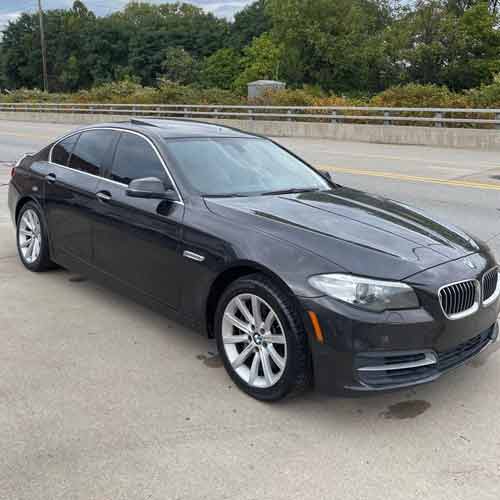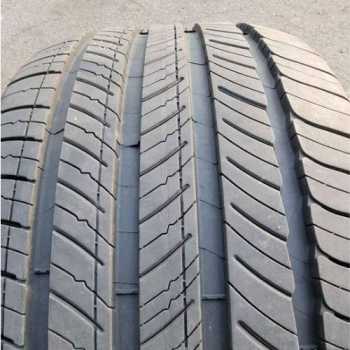The Michelin Primacy Tour A/S stands as a top pick for premium vehicles, where it gives you the quietest tread design in its class, and offers superb ice traction values. Let’s check this tire out in greater details.

The Michelin Primacy Tour A/S excels in dry conditions with great grip and steering. However, it struggles in wet and snowy terrains, but performs well on ice. Its tread life and fuel economy are average, but it stands out for its noise comfort and overall ride smoothness. The tire shines in some areas but falls short in others.
Table of Contents
Sizes Specifications
The Michelin Primacy Tour A/S comes in 17 to 22 inches rims. They all have the following specs.
- Speed ratings: H and V.
- Load ratings: SL and XL.
- Tread depth: 7 to 11/32″.
- Weight range: 25 to 37 lbs.
- Treadwear warranty: 55k miles for H and V, while 45k miles for W (speed rated) sizes.
- UTQG rating: 540 A A.
Overall Structure
Michelin Primacy Tour A/S features a 5 rib design with an asymmetric tread pattern.

Out of 5 ribs the first 2 (starting from right in the image), showcase packed up shoulder lugs, with curved inside edges, where lugs and in-groove notches also feature similar orientations.
It makes a somewhat zigzag circumferential channels with the adjacent rib, which although also features curved siping, the notches here are thicker.
The next two ribs are similar to each other, and besides similar biters like seen the rib before, here lugs also have interlocking siping and longitudinal vertical slits on them.
And lastly the shoulders on the opposite most side (left, in the image), have similar interlocking sipes, but besides that they aren’t so different from the shoulders on the other end.
Internally, the tire features 2 ply polyester cord casing, with 2 steel belts, and a singly ply polyamide cap ply on top.
Compare Michelin Primacy Tour A/S With Others
Tread Mileage
Tread longevity is influenced by several key factors, where for superior tread life, a tire should ideally feature:
- Robust Rubber Composition: This resists quick wear and tear, prolonging tire life.
- Ample Tread Depth: A deeper tread slows the rate at which a tire reaches its minimum legal tread depth, extending time between replacements.
- Lightweight Construction: Less pressure on the lugs means reduced wear.
- Balanced Tread Pattern: Uniformity in tread pattern ensures even weight distribution, preventing uneven wear and various tread deformations.
And here the Michelin Primacy Tour A/S is just okay.
Although the tire’s lighter internal construction and increased lug flexibility lead to elevated rolling resistance, its still saved by its tread depth.
I mean compred to its peers, its greater on average, so it takes a while coming down to 2/32″ (which is the minimum legal tread depth limit in the US).
That’s why although its treadwear rating is not so great at 540, its still not that bad. And yes, you also get 55k miles warranty with this tire, where its competitors cap at 50k.
Though since speed rating is directly proportional to the tire’s wear rate, the W speed rated tires only get 40k miles warranty. I explained it further here: https://tiredriver.com/speed-rating-on-tires/
Winter Performance
When it comes to winter performance, the Michelin Primacy Tour A/S gives out a very surprising outcome.
It lacks severely in terms of snow braking, acceleration and handling, but at the same time, takes the lead on ice, where the same tests render this tire the best among all (its direct competitors).
So what’s happening here?
Well, simply put, where all its competitors have ample tread biters, this tire only comes with siping, and on ice, having efficient siping is the key.
These sipes have an angular (slanted) orientation, where they also have an interlocking design. Plus you also get longitudinal siping slits on 3 out of 5 ribs.
All these offer this tire with superb ice gripping abilities. Though with missing notches, the tire can’t offer ample snow to snow contact (highly needed for snow, as it doesn’t stick as great on rubber).
Fuel Economy
Fuel consumption is influenced by several variables, including rolling resistance, tread depth, and tire’s weight and structure.
And here, the Michelin Primacy Tour A/S is pretty average, giving out similar results as its peers (direct competitors), well except for Bridgestone Turanza QuietTrack (review), which is slightly better here.
With just a single ply polyester and a single nylon cap ply the Michelin keeps its weight at bay, and so lugs aren’t pressurized below, a lot, as they rub against the road.
And so with this, there’s no significant generation of rolling resistance, and overall fuel economy is not compromised by a lot.
Overall Dry Performance
Discussing dry performance usually implicates an evaluation of two primary facets, (directional) grip and handling.
Let’s start with grip.
Directional Grip
Directional grip is the ability of a tire to maintain traction as it travels in a straight line. This attribute is shaped by several factors, such as the tread pattern, the composition of the tire, and, predominantly, the central footprint of the tire, (which gets the most weight concentration, as the tire rolls straight).
Now here, the Michelin Primacy Tour A/S is doing great.
And that is attributed to its rigid rubber composition, coupled with a densely structured central area. I mean all its central ribs are continuous running, so they form unbroken rubber to road contact.
While the angular notches on them (the in-groove biters, that you see), enhance the overall tire’s longitudinal traction further.
Lateral Grip
During cornering, a significant amount of the tire’s weight is transferred to its shoulders, allowing the lugs, there, to establish a stronger connection with the road’s surface.
And this emphasizes the importance of two key factors in determining a tire’s overall handling capability:
- The extent of the shoulder’s rubber contact with the asphalt.
- The flexibility of the lugs, or the overall tread flexibility.
The first factor influences the overall lateral grip of the tire.
And given Primacy Tour A/S having such minimalist shoulders, equipped with only lateral grooves and siping, this tire ensures exceptional road contact and delivers outstanding lateral grip.
Moreover, the reduced bending results in more direct steering response, see below.
Steering Feedback
The Michelin Primacy Tour A/S ranks high among its peers, setting some of the fastest average lap times in its category.
This tire demonstrated exceptional control, navigating smoothly through tight spaces and cornering precisely as intended by the driver.
While the steering was somewhat light, the tire exhibited consistent and responsive behavior, especially when transitioning from straight-line driving to turns.
This exemplary handling is basically form its densely packed shoulders, having reinforced foundations underneath.
Both these features basically combined to give you a pretty decent over/under steering balance, and hence superb handling times, in the premium all season category.
Overall Wet Performance
Wet performance is fundamentally about evacuating water from the tread, allowing effective rubber-to-road contact. And that is done by grooves and sipes.
Grooves take out majority of the water, and provide resistance to hydroplaning, while sipes take care of the rest, and offer with the needed grip.
Let’s discuss both these factors, one by one.
Hydroplaning Resistance
Hydroplaning represents a situation where the tire loses all contact with the ground due to water interference. That’s why grooves help here. But they can only take out so much water as the tire speeds up.
So how much speed can a tire achieves over watery surface (called float speed), directly measures this resistance.
Now, the Michelin Primacy Tour A/S, although provides good enough average straight running float speeds. It still lacks when it comes to curved float speeds, where cornering on water is done on tests.
For simplicity’s sake, this is because the tire only offers longitudinal water evacuation, (with its 4 circumferential grooves), but as its ribs are unbroken, the lateral evacuation is hindered a lot. And you see a drop in score in terms of curved aqua testing.
Wet Grip
So overall both the wet grip and handling is a step behind for our tire here, and that’s because of both, the overall lacking wet grip and steering.
I mean you get a good amount of slippage on corners (when pushed), where once it begins to skid due to a loss of front-end grip, regaining control proves to be quite a task.
Moreover, the overall steering also feels indistinct and non-linear.
So why the tire is lacking here?
To comprehend the reason behind this deficiency, it’s essential to understand the role of siping.
Sipes are slits in the tire that aid in absorbing and expelling water particles by creating suction “as they flex”, allowing the rubber/tread biters to grip onto the (relatively) drier surface.
Now the problem with Michelin Primacy Tour A/S is its relatively stiff rubber compound.
This rigidity impedes the sipes’ ability to effectively absorb and release water, consequently diminishing the tire’s wet traction.
Road Noise
When it comes to noise comfort, the Michelin Primacy Tour A/S offers one of the best composition and tread design.
You see noise primarily arises from the interaction between air particles and the tire’s tread walls.
Air enters through shoulders and hit the walls around generating what they call “tread noise”.
Now the Michelin comes with ridges between the shoulder lugs, so air is restricted to move in (a lot). This kills noise at the source.
Moreover, its tread compound features polymers that are very absorbent of noise waves, so they don’t amplify and generate in-groove resonance.
So What’s The Verdict?
The Michelin Primacy Tour A/S offers a mixed bag of performance.
In dry conditions, it stands out with exceptional grip and steering feedback, thanks to its rigid rubber composition and tailored tread design.
However, its performance dips in wet conditions, notably lacking in lateral water evacuation and wet grip.
In snowy conditions, it falls behind, but surprisingly excels on icy terrains due to its efficient siping.
And despite it having an average fuel economy and tread mileage, the tire shines in noise comfort and provides a commendable ride experience.
Trying to decide between the CrossClimate 2 and the Primacy Tour A/S for my 2021 Rogue SL. I’ve noticed road noise on rough pavement with the Alenzas that came with the car. Also the Alenzas only lasted 42K before the tread was worn to where I’m uncomfortable driving in medium to heavy rain. The car lifts off the road with just a little water in a lane.
Yes I know exactly what you’re saying. Alenzas do that.
P.S. Out of all these tires the Primacy Tour A/S are just great for wet conditions. As for noise I think that’s better on CrossClimate 2 if I remember correctly. Make sure to check out these tires’ individual reviews.
Thank you for the response. I’m trying to decide between the Primacy Tour A/S and the Alenza AS Ultra. The car’s suspension is very tight and I’m looking to improve the ride.
Well for that Alenza AS Ultra would suit you better.
I don’t understand your reply to Doug’s question? In your review, you said the Primacy was not good at wet traction, but when you answered his question, you said it was great at wet traction?? Please explain? Is it good or is it bad at wet traction?